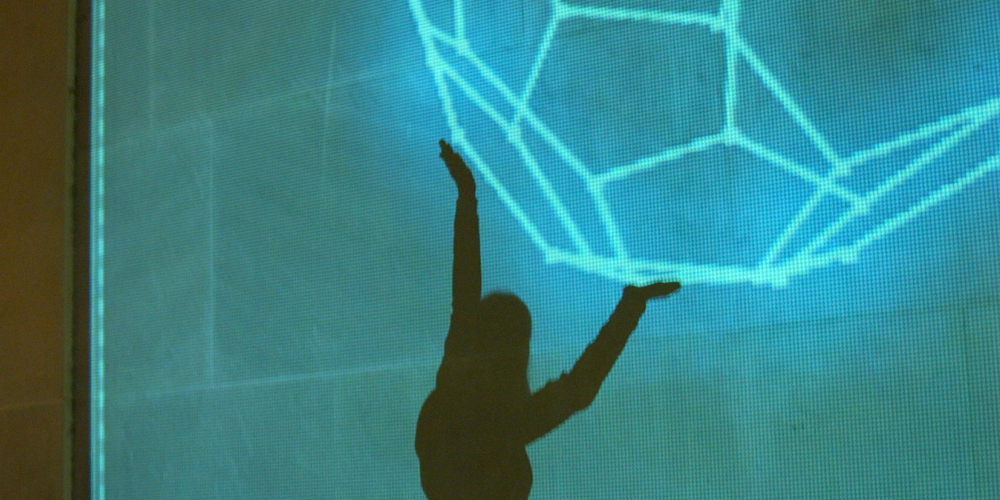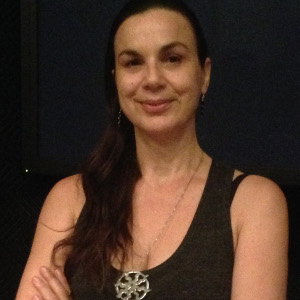
Victoria Vesna is a well-known and important artist in the media art and professor at the UCLA Department of Design | Media Arts and Director of the Art|Sci center at the School of the Arts and California Nanosystems Institute (CNSI). Her work can be defined as experimental creative research that resides between disciplines and technologies. With her installations she explores how communication technologies affect collective behavior and how perceptions of identity shift in relation to scientific innovation.
Victoria is one of the four jurors who will select the prizewinners in the 2015 Prix Ars Electronica’s Hybrid Art category. During our recent chat, she elaborated on how she defines this highly complex genre, what she’s working on at the moment, and what she looks for when assessing works of hybrid art.
Victoria, in recent years, there have been lots of discussions about what sort of art a genre that combines multiple disciplines actually is. For precisely this reason, it’s not easy to say what exactly hybrid art is. Could you please try to describe what hybrid art is for you?
Victoria Vesna: In my opinion, hybrid art resides in between, around, above and below what is generally accepted as “culture” and usually is experimental and exploring new ideas that require collaboration with other disciplines. Many times it is not even considered art by the established art world because hybridity does not subscribe the usual, established categories or definitions. Ultimately, one could say that this is contemporary art in process and as soon as it is defined it changes to something else. Often this kind of work is ahead of its’ time and thus neglected and misunderstood so many great ideas disappear or are experienced by too few to make it significant. Current extreme global times are reflected in artistic explorations that go beyond computer technologies and into the heart of scientific laboratories where change is accelerating at a furious pace. And, because conventional methodologies in research cannot be applied to recent discoveries, scientists are being more and more open to working with artists. So hybrid arts becomes even more complex to explain and perhaps even more confusing for those that want clear straightforward answers.
 Zero @ Wavefunction (Credit: Victoria Vesna)
Zero @ Wavefunction (Credit: Victoria Vesna)
The tools of media art are constantly changing. Has this also already changed the meaning of the still very young concept of Hybrid Art?
Victoria Vesna: Tools of media art change according to what we discover or create with them so one influences the other in an evolutionary way. Technological advances go naturally hand in hand with artists exploring new areas of expression and we reflect the current state of collective mind that is endlessly in shift and moving from one extreme to the next. This all points to a major paradigm shift that we are all in the midst of and artists can in some small way point the way or present another way of seeing things, of interpreting events in time and space we occupy.
Are there any trends in Hybrid Art at the moment? Are there parallels to current political or social topics?
Victoria Vesna: There is no one trend in any field anymore and maybe that would be the answer to your question. I would say that environmental issues that extend out into everything from the food we eat, the water we drink, the animals we live with to the fuel and other power issues are increasingly reflected in the work produced. Whether artists decide to specifically address these and other related social and political issues specifically is not so important as every single expression is mirroring the current topics and at the base is a product of the current global situation. We are in a state of turmoil and artists practicing hybrid art are responding by using the tools that are most easily accessible and understandable – using communication technology that is ubiquitous and connecting everyone in good and bad ways.
 Quantum Tunneling (Credit: Victoria Vesna)
Quantum Tunneling (Credit: Victoria Vesna)
Your works are also mostly transdisciplinary and deal with art, science and (nano-) technology. What is your appeal to combine different genres?
Victoria Vesna: New science fields such as nano and bio technology would not exist without computer technologies and their rise happened in parallel to evolution of media arts. Traditional scientific methodologies do not work so well for these fields that are inherently interdisciplinary and the same is true for art making so the overlap can be quite natural and creative. My long term friendships and relationships to scientists naturally evolve into projects in which we together explore philosophical ideas in action through collaboration. We are driven by the same exploratory curiosity to understand the world around us, our role in it and even the meaning of existence and after a while get bored to just talk about it. So the projects become a manifestation of the dialogues that ultimately change and/or expand our respective minds.
For the past few years you have also been collaborating with nano-science pioneer, James Gimzewski. How was the collaboration? What were you working on?
Victoria Vesna: Actually, it is more than a few years – it’s been over a decade! I have collaborated with James Gimzewski since 2002 and continue to work together and when we create a piece that is in between art and science, we feel satisfied. My entrance into nanotechnology was through my interest in the work of Buckminster Fuller – specifically looking into how natural systems informed his architectures and the philosophy behind his work. I learned that a year after he passed away (1985), a new molecule, the third allotrope of carbon (C60) was discovered and eventually led to the award of the 1996 Nobel Prize to Sir Harry Kroto of Sussex University, Robert Curl and Richard Smalley of Rice University in Houston, USA. Smalley’s laboratory equipment could only tell them how many atoms there were in the molecule, not how they were arranged or bonded together and they used Fuller’s model to deduce that the atoms were arrayed in the shape of a truncated icosahedron – a geodesic dome.
2001 I organized a symposium “From Networks to NanoSystems” and invited James Gimzewski because I wanted to make sure that the discussion was not only between artists and humanists but also included someone who actually worked in nanoscience. It turned out that he was researching buckyballs and even had some of the same slides in his presentation as I, but was not aware of Buckminster Fuller. So we started learning from each other and very soon we created our first piece, “Zero @ Wavefunction” (2002) where audience manipulate projected bukyballs with their shadows. This was followed by a series of works including Nanomandala, Quantum Tunnel, Cell Ghosts and most recently Blue Morph. For the past few years James has been working on developing an Artificial Brain and is really interested in self-organized criticality and we are talking about doing a new piece.
What are you looking for as a juror in the evaluation of the submitted works at the Prix Ars Electronica 2015?
Victoria Vesna: I always look for work that is daring, complex, resides at the edge and can be interpreted from many different levels. There are no particular rules or formulas to my method – I listen to my inner feelings when looking at work and like being surprised with the unexpected. Prix Ars Electronica is known to search and showcase innovative technological as well as conceptual works so I am looking forward to the submitted work.

Victoria Vesna, Ph.D., is an Artist and Professor at the UCLA Department of Design | Media Arts and Director of the Art|Sci center at the School of the Arts and California Nanosystems Institute (CNSI). With her installations she investigates how communication technologies affect collective behavior and perceptions of identity shift in relation to scientific innovation (PhD, University of Wales, 2000). Her work involves long-term collaborations with composers, nano-scientists, neuroscientists, evolutionary biologists and she brings this experience to students. She is the North American editor of AI & Society and in 2007 published an edited volume – Database Aesthetics: Art in the Age of Information Overflow and another in 2011 – Context Providers: Conditions of Meaning in Media Arts
Find more information about the Prix Ars Electronica: https://ars.electronica.art/prix/
